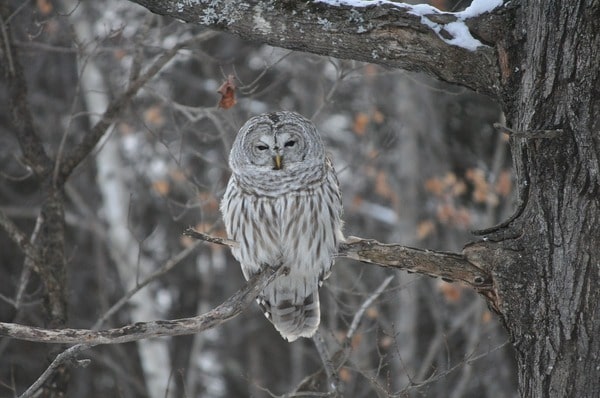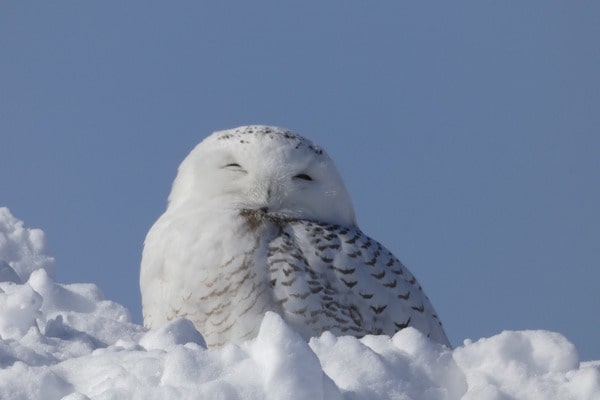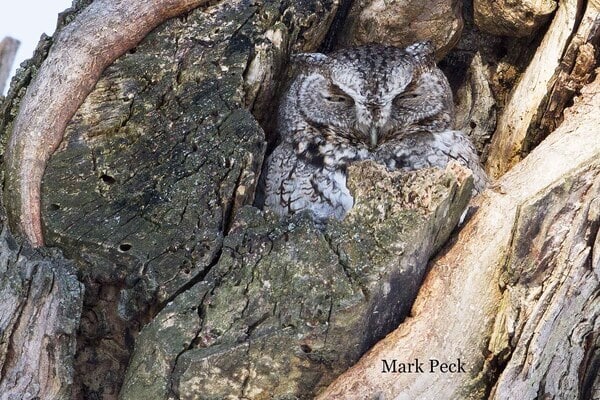Owls do not hibernate– they stay active all year, even in freezing winters. Instead of entering long-term dormancy like some mammals, owls survive the cold through powerful natural adaptations: dense insulating feathers, efficient energy use, strategic roosting, and flexible hunting behavior.
Some small species can enter short-term torpor, a brief drop in body temperature to conserve energy, but this is not true hibernation. From Arctic Snowy Owls to temperate Screech Owls, each species uses a unique set of physiological and behavioral tools to endure snow, scarce prey, and harsh winds. Understanding how owls handle winter provides a clearer look at their resilience, metabolism, and remarkable survival strategies.
How Owls Survive Winter Without Hibernating: Energy, Behavior & Adaptations
Owls stay alert through winter because their bodies are built for cold weather. Their feathers are packed tightly enough to trap heat the same way winter clothing does for humans. Even their legs and feet are insulated in many species, which helps protect them when they perch on frozen branches.
Their internal temperature stays steady thanks to a warm-blooded metabolism that never shuts down. Instead of hibernating, owls simply reduce unnecessary activity, choose warmer roosting spots, and rely heavily on their hearing to hunt when snow hides their prey.
Key Points
- Feathers act as natural insulation, even around the legs and toes.
- Warm-blooded metabolism prevents any need for hibernation.
- Owls select sheltered roosts to block wind and conserve heat.
- They use sound to locate prey moving under snow.
How Different Owl Species Handle Winter From Snowy Owls to Screech Owls
Each owl species faces winter in its own way. Snowy Owls are naturally built for the Arctic; their thick plumage and large size let them handle freezing winds and long stretches of snow-covered ground. When their usual prey becomes scarce, they shift to hunting birds or scavenging when needed.
Great Horned Owls don’t back down from winter either. They continue hunting large prey even during storms and often nest earlier than most birds, showing how well they tolerate cold.
Screech Owls, on the other hand, rely more on sheltered tree cavities. They stay tucked away during the coldest periods and are one of the few owl species known to enter short-term torpor.
Key Points
- Snowy Owls thrive in Arctic conditions through heavy insulation.
- Great Horned Owls stay active and hunt even in storms.
- Screech Owls use tree cavities and may rely on brief torpor.


What Really Happens to Owls in Winter? A Data-Backed Look at Their Physiology
Winter doesn’t push owls into any kind of deep sleep or seasonal shutdown. Their bodies stay fully active because owls are homeothermic- they hold a steady internal temperature even when the environment drops far below freezing. This stability comes from their metabolism, which works harder in winter to replace heat lost to cold air. As the temperature drops, their energy use naturally increases, not decreases.
A major part of their winter resilience comes from their feathers. Owls have extremely dense plumage that traps warm air close to the body, creating insulation similar to a natural thermal jacket. In northern species, the insulation goes even further, covering the legs, feet, and toes to prevent heat loss on frozen perches. Snowy Owls in particular show how effective this system is: their plumage and body heat allow them to stay comfortable even in Arctic winds.
Because staying warm demands more energy, owls shift their behavior to protect their physiology. They pick sheltered roosts that block wind, helping them conserve calories. They also remain highly efficient hunters, using their hearing to find prey under snow when visual cues disappear. At no point do they enter hibernation or any long-term metabolic shutdown- studies show that even in the coldest months, their core temperature stays stable.
Some small owls add one more tool to the mix. Species like the African Scops-Owl can enter short bouts of shallow torpor when mornings are especially cold and insect prey is limited. This brief slowdown lasts only a few hours and helps reduce energy waste. But even then, the owl stays ready to wake instantly. For larger owls, this kind of metabolic dip doesn’t appear at all.
Key Points
- Owls stay homeothermic, keeping a stable internal temperature in winter.
- Their metabolism increases to produce more heat, raising energy demands.
- Dense feathers-and in some species feathered legs/feet- provide strong insulation.
- Only a few small owls use brief torpor; larger species remain fully active.
Do Owls Get Sleepier in Winter? Truth Behind Their Routine
Owls don’t increase their sleep during winter, even when temperatures drop sharply. Their daily rhythm stays surprisingly stable because they rely on a warm-blooded metabolism that never shuts down seasonally. Instead of sleeping more, they simply adjust how they use energy. On colder days, owls spend extra time perched in sheltered areas to limit heat loss, but this behavior is about conservation, not extra sleep.
Most owl species stay fully homeothermic throughout winter, meaning they maintain a steady internal temperature regardless of how cold it gets. This has been confirmed in studies of species like the Pearl-Spotted Owlet, which showed no sign of torpor and kept its body temperature stable even in winter conditions. Larger owls that hunt mammals also benefit from reliable prey availability, so they don’t need extreme energy-saving mechanisms.
However, a few small insect-eating owls behave differently. Research on the African Scops-Owl shows that it can enter short bouts of shallow torpor, usually just after sunrise. During this time, its body temperature drops a few degrees and its metabolic rate slows briefly to conserve energy when insects are scarce. Even then, torpor is temporary typically lasting only a few hours and the owl remains capable of waking quickly if disturbed or if an opportunity to hunt appears.
Because winter increases the energy demands on owls, especially at night, these adjustments help them maintain balance. But the core pattern remains the same: winter does not trigger extra sleep, only smarter energy use.
Key Points
- Winter does not make owls sleep more; their rhythm stays stable.
- Homeothermic species keep body temperature steady even in winter.
- Only a few small owls use brief torpor to save energy when prey is limited.
Related Post
- Owl Beak : A to Z Guide
- Do Hawks Eat Owls – Explanation
- Do Owls Eat Chickens – Explanation
- Are owls Omnivores
- Do Owls Eat Squirrels
Resources
- https://www.birdwatchingusa.org/
- https://opticsmag.com

